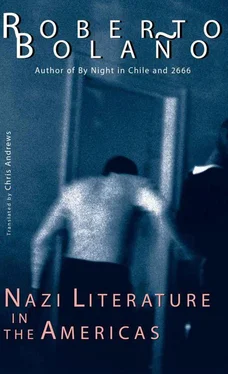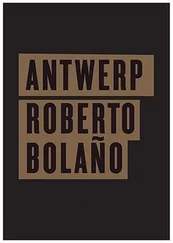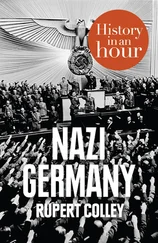Little is known about the remainder of Zubieta’s work. According to some, nothing more remained, or only a few disappointing squibs. For a while there was speculation about a diary totaling more than 500 pages, which Zubieta’s mother had burned.
In 1959, a far-Right group in Bogotá published a book entitled Iron Cross: A Colombian in the Struggle Against Bolshevism (clearly Zubieta was responsible neither for the title nor the subtitle), having obtained the authorization of Lemercier, but not of Zubieta’s family, who took the Frenchman and the publishers to court. The novel, or novella (80 pages long, including five photographs of Zubieta in uniform, one of which shows him smiling coldly in a Paris restaurant, exhibiting the only Iron Cross awarded to a Colombian during the Second World War) is a hymn to friendship among soldiers; it balks at none of the clichés that recur in the voluminous literature on that theme, and was described at the time by a critic as a cross between Sven Hassel and José María Pemán.
Cartagena de Indias, 1910–Berlin, 1945
Until The Fourth Reich in Argentina published two of his books, more than thirty years after his death, the life and work of Jesús Fernández-Gómez remained entirely obscure. One of those books was The Fighting Years of an American Falangist in Europe , a 180-page quasi-autobiographical novel, written in thirty days, while the author was recovering from his war wounds in the Riga military hospital; it recounts his adventures in Spain during the Civil War and in Russia as a volunteer in the Division 250, the famous Spanish Blue Division. The other book is a long poetic text entitled Cosmogony of the New Order .
This second volume is composed of three thousand verses, each with a note to indicate where and when it was written: Copenhagen 1933—Zaragoza 1938. A poem of epic aspirations, it tells two stories, constantly juxtaposing them and jumping from one to the other: the story of a Germanic warrior who must slay a dragon, and the story of a South American student who must prove his worth in a hostile milieu. One night the Germanic warrior dreams that he has killed the dragon and that henceforth, in the kingdom it had long tyrannized, a new order shall prevail. The South American student dreams that he must kill someone, and in his dream obeys the order, obtains a gun, and enters the victim’s bedroom, in which he finds only “a cascade of mirrors, which blind him forever.” The Germanic warrior, reassured by his dream, goes unsuspectingly to the battle in which he is to die. The South American student will spend the rest of his life wandering, blind, through the streets of a cold city, paradoxically comforted by the splendor that caused his blindness.
The first pages of The Fighting Years of an American Falangist in Europe relate the author’s childhood and adolescence in the city of his birth, Cartagena: the “poor but honest and happy family” in which he grew up, the first books he read, the first poems he wrote. Fernández-Gómez goes on to recount how he met Ignacio Zubieta in a Bogotá brothel; how the two young men became friends; the ambitions they shared; and their desire to see the world and break free of family ties. The second part of the book tells of their early years in Europe: the apartment they shared in Madrid, new friends, their first quarrels (occasionally they came to blows), dirty old women and men, how it was impossible to work in the apartment, the long hours Fernández-Gómez spent holed up in the National Library, and travels that were generally pleasant but occasionally wretched.
Fernández-Gómez marvels at his own youth: he writes of his body, his sexual potency, the length of his member, how well he holds his liquor (although he detests alcohol and only drinks to keep Zubieta company), and his ability to go for days without sleep. He also marvels gratefully at the ease with which he can withdraw into himself at moments of crisis, the solace he finds in the practice of literature, the great work he hopes to write, which will “ennoble him, wash away all his sins, endow his life and his sacrifices with meaning,” although he declines to divulge the nature of these “sacrifices.” He tries to write about himself and not Zubieta, in spite of the fact that Zubieta’s shadow “clings around his neck like an obligatory tie or a lethal bond of loyalty.”
He does not expand on political themes. He deems Hitler Europe’s providential savior, but says little more about him. Physical proximity to power, however, moves him to tears. The book is full of scenes in which, along with Zubieta, he attends soirées, official functions, medal ceremonies, military parades, church services and dances. The men in positions of authority, almost always generals or prelates, are described in lingering detail, with the tenderness of a mother describing her children.
The Civil War is his moment of truth. Fernández-Gómez throws himself into it with enthusiasm and courage, although he realizes at once, and informs his future readers, that the constant companionship of Zubieta will be no small burden. His evocation of Madrid in 1936—a city where he and Zubieta move like ghosts among ghosts, in search of friends hiding from the Red Terror, and visit Latin American embassies where they are received by demoralized diplomats who can tell them little or nothing — is vivid and striking. It does not take Fernández-Gómez long to adapt to the extraordinary circumstances. Army life, the hardships of battle, the marches and countermarches do not dull his keen fighting spirit. He has time to read and write, to help Zubieta, who is largely dependent on him, to think of the future and make plans for his return to Colombia, plans he will never put into practice.
Almost as soon as the Civil War is over, Fernández-Gómez volunteers for the Blue Division’s Russian adventure, along with Zubieta, to whom he is closer than ever. The battle of Possad is recounted realistically, in harrowing, unflinching detail, without a trace of lyricism. The descriptions of bodies destroyed by artillery fire occasionally bring to mind the paintings of Francis Bacon. The final pages evoke the sadness of the Riga Hospital, the solitude of the bedridden warrior, far from his friends, left behind to endure the melancholy Baltic evenings, which he compares unfavorably to the evenings of his distant Cartagena.
Although unedited and unrevised, The Fighting Years of an American Falangist in Europe has the power of a work based on extreme experience, as well as containing various colorful observations on lesser-known aspects of Ignacio Zubieta’s life, over which we shall pass in discreet silence. Among the numerous grievances addressed to Zubieta by his brother in arms convalescing in Riga we note only one, of a purely literary nature, regarding the authorship of the Schiller translations. In any case, and whatever the truth of that matter, we know that the two friends met again, albeit in the presence of a third party, the painter Lemercier, and that together they resumed the struggle, this time in the controversial Brigade Charlemagne. It is hard to know who led whom into that final adventure.
The last work of Fernández-Gómez to come to public notice (although there is no reason to fear that it is really the last ) was the erotic novella The Countess of Bracamonte , which appeared under the Odin imprint in the Colombian city of Cali in the year 1986. The informed reader will have no trouble identifying the protagonist of this story as the Duchess of Bahamontes, and her two antagonists as the inseparable Zubieta and Fernández-Gómez. The novella is not without humor, which is remarkable, given the place and date of its composition: Paris, 1944. Fernández-Gómez no doubt indulged in a certain amount of embellishment. His Duchess of Bracamonte is 35 years old, not forty-something, the estimated age of the real Duchess. In Fernández-Gómez’s novel the two young Colombians (Aguirre and Garmendia) share the noble lady’s nights. During the day they sleep or write. The descriptions of Andalucian gardens are meticulous and, in their way, interesting.
Читать дальше












